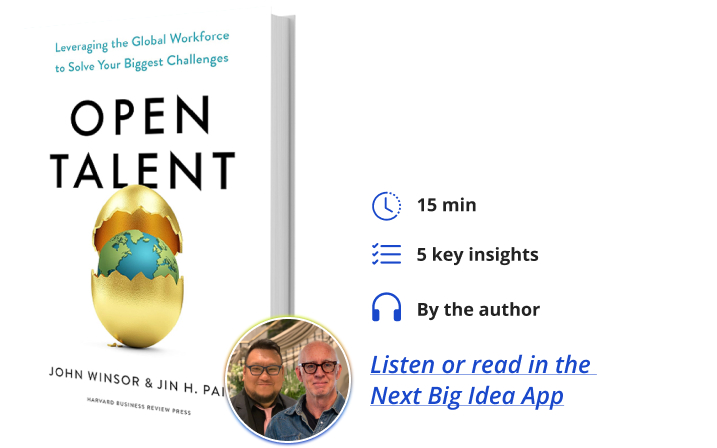John Winsor is the founder and chair of Open Assembly, the world’s leading authority on the open talent economy. He is an executive in residence at the Laboratory for Innovation Science at Harvard.
Dr. Jin H. Paik is a co-founder and managing partner at Altruistic, an AI consultancy, and a principal visiting research scientist at Harvard Business School. He was previously the Head of Labs at the Digital, Data, and Design Institute at Harvard and the founding general manager at the Laboratory for Innovation Science at Harvard. He holds degrees from the University of Michigan, Harvard, and NYU.
Below, co-authors John and Jin share six key insights from their new book, Open Talent: Leveraging the Global Workforce to Solve Your Biggest Challenges. Listen to the audio version—read by John—in the Next Big Idea App.

1. Companies need to shift their mindsets to become networked organizations in the new world of work.
A networked organization is a modern business structure characterized by dynamic, interconnected relationships, both internally among employees and externally with freelancers, partners, and other stakeholders. This organizational model moves away from traditional hierarchical systems to a more fluid, collaborative approach, leveraging digital technologies for communication and project management. In a networked organization, decision-makers and decision-making are often decentralized, empowering individuals at various levels to contribute ideas and take the initiative.
This focus is on agility, adaptability, and leveraging a diverse range of skills and perspectives to drive innovation and respond effectively to changing market conditions. Collaboration is the key with teams forming and reforming as needed around projects or initiatives. This structure supports a blend of full-time, part-time, and freelance talent, enabling the organization to scale resources up and down based on demand and to access specialized skills as needed. The networked organization thus embodies a more flexible, responsive, and collaborative approach to business in the digital age.
2. Companies must focus on evolving their culture and becoming a networked culture.
A network culture in an organization signifies a collaborative, interconnected environment where communication and knowledge flow freely across traditional boundaries. It transcends hierarchical structures, encouraging more flexibility, inclusivity, and a dynamic approach to working.
In this culture, employees, regardless of their position, are empowered to share ideas, contribute to decision-making, and collaborate across departments and teams. Technology plays a crucial role, facilitating seamless connections and enabling remote and asynchronous collaboration. This culture values diversity, encouraging a variety of perspectives and inclusive practices, which contribute to innovation and problem-solving.
“Employees, regardless of their position, are empowered to share ideas, contribute to decision-making, and collaborate across departments and teams.”
A network culture fosters a sense of community and shared purpose, where relationships and networks are nurtured not only within the organization but also with external partners and stakeholders. It supports a mindset of continuous learning and adaptation, which is essential in a rapidly evolving business landscape.
3. Establish a center of excellence (COE) for assessing, learning, and experimenting with open talent.
It’s crucial for organizations venturing into the flexible work domain. This dedicated entity functions as a hub of expertise, best practices, and leadership for open talent initiatives, ensuring a strategic and coordinated approach. It plays a vital role in navigating the complexities of integrating external talent, including compliance, quality control, and alignment with organizational objectives.
The COE serves as a learning platform where insights and experiences are systematically gathered and analyzed to refine processes and strategies continuously. By fostering experimentation and innovation in open talent management, it enables the organization to adaptively scale these initiatives, align them with business goals, and extract maximum value.
Moreover, the COE ensures consistent and effective communication across departments, helping to overcome resistance and build a cohesive framework for integrating open talent into the company’s broader talent and business strategies. Essentially, the COE acts as a central nervous system that guides, educates, and supports the organization in leveraging the open talent ecosystem efficiently and sustainably.
4. Build an external talent cloud.
An ETC refers to a virtual pool or network of external professionals, freelancers, contractors, and consultants. An organization can access and utilize this network for various projects and tasks. This cloud-based approach to talent management leverages digital platforms and technologies to connect businesses with a global, flexible workforce on demand.
“This model fosters a more dynamic, cost-effective, and strategic approach to talent acquisition.”
It allows companies to tap into a wide range of skills and expertise, which might not be available in-house, and to scale their workforce up or down quickly, depending on project needs. The external talent cloud is particularly beneficial for accessing specialized skills, supporting innovation, and providing agility in responding to market changes or business opportunities.
This model fosters a more dynamic, cost-effective, and strategic approach to talent acquisition. This enables organizations to adapt swiftly to evolving business challenges and opportunities while optimizing labor costs and enhancing productivity.
5. Build an open innovation capability.
Open innovation contest capabilities encompass the strategies and tools that an organization employs to run competitions aimed at sourcing innovative ideas, solutions, and technologies from a wide range of external contributors.
These contests, often hosted on digital platforms, invite individuals, startups, researchers, or other organizations to submit proposals addressing specific challenges or opportunities defined by the hosting company. The capabilities needed for successful contests include designing clear, engaging challenge statements, effectively managing submissions, fostering participation engagement, and ensuring fair and transparent judging processes.
“Open innovation contests are powerful because they tap into diverse global talent pools.”
Additionally, they involve leveraging digital tools for outreach and collaboration, maintaining intellectual property rights frameworks, and integrating the winning ideas into the company’s innovation pipeline. Open innovation contests are powerful because they tap into diverse global talent pools, often unearthing novel perspectives and solutions that internal R&D might overlook, thus driving breakthrough innovation and fostering a culture of creativity and collaboration beyond organizational boundaries.
6. Build an internal talent marketplace.
An internal talent marketplace is an innovative organizational platform that matches employees’ skills, interests, and career aspirations with internal projects, roles, and short-term assignments within the company. This digital marketplace operates much like an in-house open talent economy, allowing employees to explore and take on diverse work opportunities beyond their traditional job descriptions.
It enables organizations to optimize their workforce by effectively deploying human resources where they are most needed, enhancing workforce flexibility and agility. This approach not only maximizes the utilization of available skills and talent but also fosters employee growth and satisfaction by offering varied experiences and development opportunities.
By breaking down silos and encouraging cross-functional collaboration, an internal talent marketplace nurtures a dynamic, engaged, and adaptive workforce, aligning employee aspiration with organizational needs. It also fosters a culture of continuous learning and innovation.
To listen to the audio version read by co-author John Winsor, download the Next Big Idea App today:





























